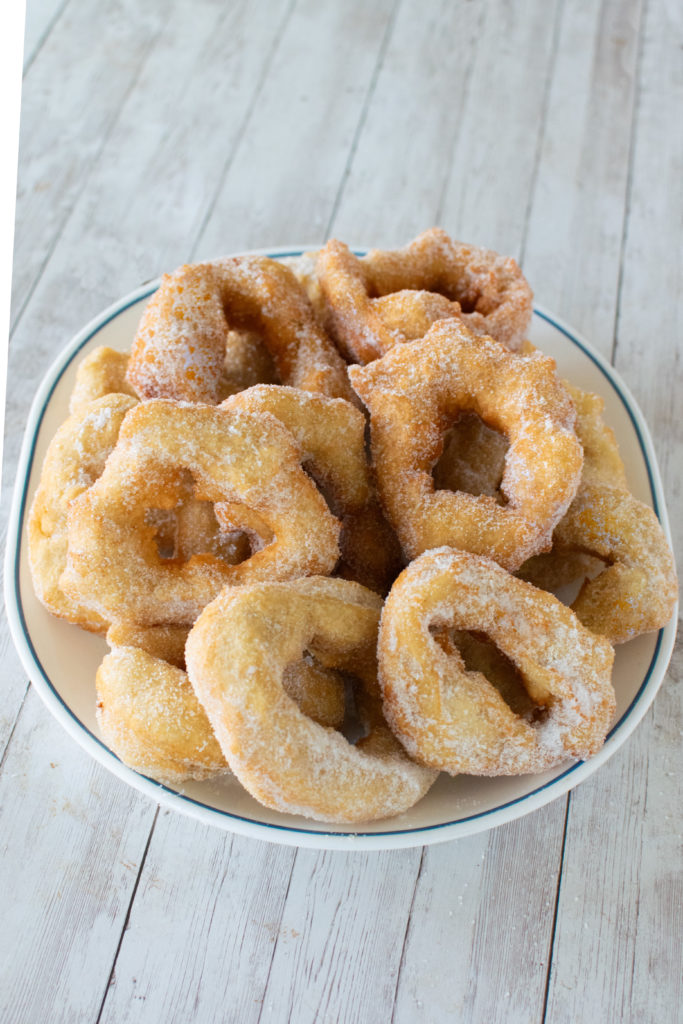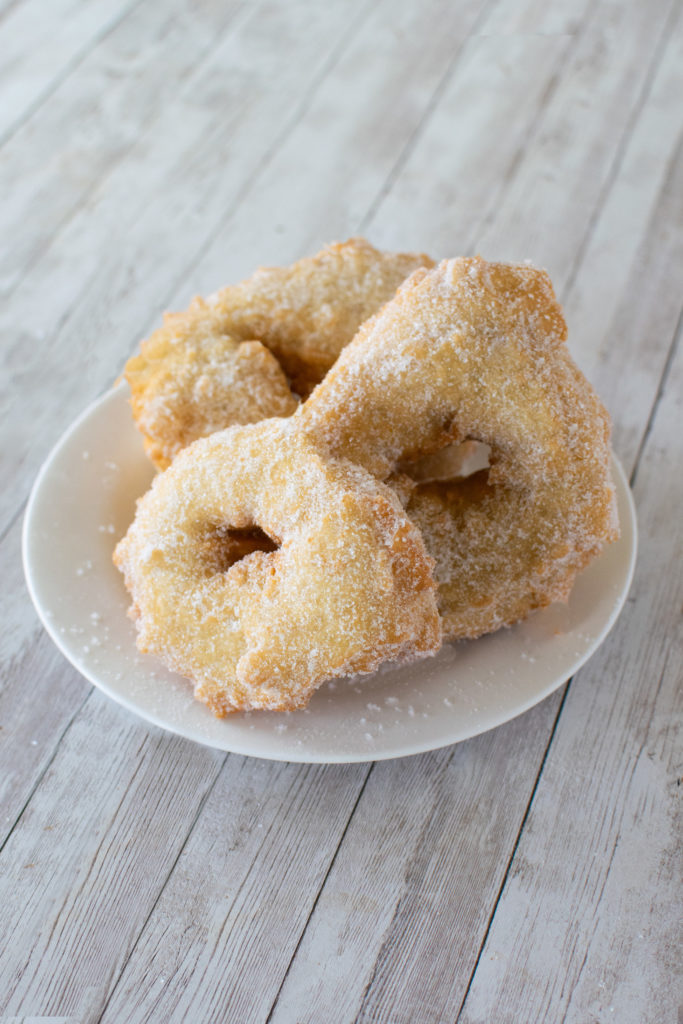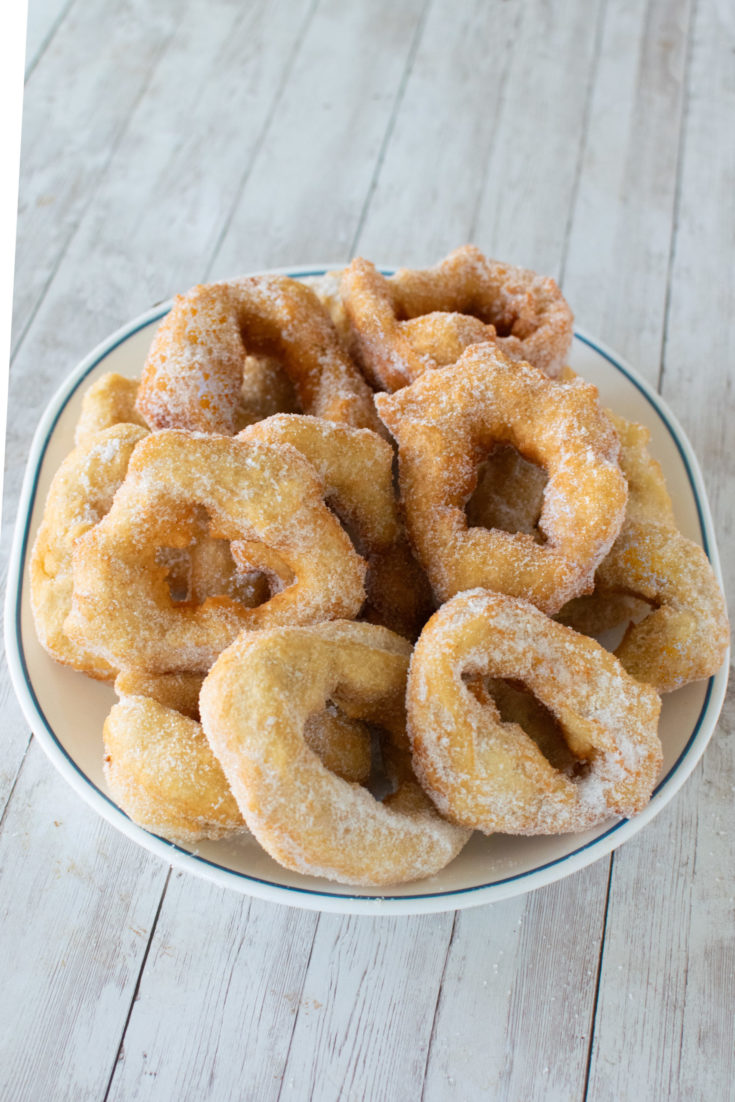Easy Sfinge is a recipe for Moroccan doughnuts or fritters. They are dairy-free, very easy to make, and absolutely delicious.

Easy Sfinge is a recipe for deep fried Moroccan doughnuts. They are easier to make than regular doughnuts, because the beauty of making them is that they are not supposed to have a perfect shape but rather they come out, how they come out.
Sfinge, or sfenj, is a free-form doughnut or fritter. Just grab some of the dough form into a random ring and drop into hot oil. Then, roll in granulated sugar, and you have an amazing treat!
Some people don’t even bother to form a ring and drop them as balls into hot oil (I once had them as small as dounut holes).
In Morocco, they are a popular street food. Sfinge is also eaten in Italy and Sicily.
Moroccan Jews brought the treat to Israel where Sfinge are eaten during Chanukah just like the popular sufganiya (which is a doughnut without a hole and filled with jelly or caramel).
Moroccan Jews in Israel
The majority of Moroccan Jews in Israel are the descendants of Jews that immigrated to Israel from Morocco.
Before the establishment of the State of Israel, the British put a quota on the amount of Jews that could immigrate to Israel, so most of the immigration was considered “illegal.” However, many Jews risked their lives to flee their countries of origin, including Arab and Muslim countries, such as Morocco.
Because the Muslims were against the establishment of the State of Israel, after the declaration of the state and the civil war that followed, life became more difficult for the Jews of Morocco, because the Muslims would attack Jews as a result. This brought about a wave of immigrants to Israel from Morocco, as did every Arab-Israeli war that followed.
So, during the 1950s and for decades afterward, waves of Moroccan Jews immigrated to Israel.
Morocco was once the home of the largest Jewish community in the Muslim world. However, by the time of the Yom Kippur war, the majority of Morocco’s Jews had immigrated to Israel, and they brought their delicious cuisine with them.
One can make the dough rings think or fat or in between. They will still be delicious!

If I can bake, anyone can
I am the type of person who, when she sees something that looks easy to create, will try to do just that. It doesn’t really matter what it is.
And if I don’t at first succeed, I will continue to try and try until I complete the project or until I decide that I have at least given it my best effort and have had enough.
For example, when my eldest son (I have 5) sent me a video of an apartment he was thinking of renting, I saw a painting on a wall. The canvas was completely covered with uneven clouds of various colors and a long line of white squiggled randomly over it. My first thought was why something so simple could actually be considered a work of art, and my second thought was, Hey, I totally can paint something like that, and I did (MUCH smaller, of course).
But then there was the picture with crayon drippings in various beautiful colors (I am a sucker for colors). I had a bunch of old crayons, and I tried it. However, when I heated them to melt, the colors kept dripping across one another, and I couldn’t get them to drip straight down in their own paths. The repeated attempts didn’t pan out too well, and not only did I get crayon drippings on the canvas, I got them all over the kitchen. So, THAT was one of those times where I agreed with myself to give up.
And there have been so many other projects (people like me are a thing—we will spend $80 to craft something that would cost $5.99 to buy in the store).
Anyway, so, one day after a visit to a bakery one day, I decided that I should totally try baking (I could already cook).
I started with chocolate chip cookies. While chocolate chip cookies aren’t hard to make, and they always come out tasting good (unless I forget to take them out of the oven on time and they burn), I found it a challenge to get them to come out the way I had envisioned.
Sometimes they came out too cakey, sometimes too dry, sometimes too flat, and sometimes they spread out into one another.
But every so often, they would even come out just right. And it was those times—and the fact that my kids loved them no matter how they came out—that gave me encouragement to try again. And again. And again.
My next attempt at baking was birthday cakes. I am not sure why I decided to do this since the boxed kind are perfectly fine, but whatever.
I started with a 9″x13″ pan, and those sheet cakes came out fine, but they weren’t “real” birthday cakes. You know, like a round one. With layers.
So, I baked a cake with layers.
As with the sheet cakes, it came out tasting terrific, but the layers weren’t flat and the cake came out lopsided. Like with other things, I tried over and over (we have a lot of birthdays), but the layers always came out unlevel. I solved the problem by filling out the valleys with frosting.
I knew that when this happens, the layers need to be leveled off by cutting away the excess, but that would’ve meant removing too much, and I would’ve ended up with a very short cake, so I wouldn’t do it.
Luckily, I did find out that there is a way to prevent uneven layers, which is by using baking strips. Simple as that.
I did learn a very valuable lesson while I was still struggling with the lopsidedness of my cakes, and that was NEVER to put frosting on the cake until the layers have completely cooled because if the layers are still hot, or even warm, the frosting will get runny. Not only will this prevent a nicely decorated cake, but if it is not level, everything you put on top of the cake will…slide…right…off. Seriously.
Actually, I learned another lesson as well. If you have unevenness in your layers, just cut the higher portion of the cake (the part that you would cut off to make it level) horizontally down the middle and flip the top part of that over on to the lower part of the layer, it will mostly level it off. THEN you can spread on the frosting and decorate without losing height.
Talking about height, with the issue of the uneven cake layers solved, the next thing I wanted to improve was the height of my cakes. For some reason, I didn’t think that the layered cakes that were higher were probably three-layer cakes. I just thought that my two-layer cake should be higher. So, I did what any person who didn’t bother to do ANY research would do. I doubled the recipe.
Just like before, the cake came out tasting good, but it was no longer moist and fluffy. In fact, it was kind of heavy.
I am pretty sure now that my issues with baking were because of the way that I cook because I am the type who can eyeball some of the ingredients, and the food still comes out good.
That is NOT so with baking. At least not with me.
Anyway, so back to my heavy cake.
I couldn’t figure out what was wrong, and I complained to my daughter, Elissa, about how my cake wasn’t coming out like it used to, and her first question was the obvious.
“Mom, did you follow the instructions?”
I told her, “Yes, I followed the directions. But look at it!”
Elissa insisted that I must’ve done SOMETHING wrong and decided that she would make the same cake (she always follows directions) and see how HERS came out. So, I read the instructions to her while she made the batter.
When Elissa’s cake came out just as heavy as mine, she almost cried, but I felt kind of gratified that whatever was wrong wasn’t MY fault. Ha!
Then she asked to see the recipe for herself so she could see what could possibly have gone wrong, and she was surprised.
“These are half of the quantities that you read to me. You doubled the recipe. Why??”
I told her that I wanted a higher cake.
“That is NOT considered following directions. The recipe is for two pans, and you put double in each pan, so it couldn’t rise.”
Oh.
I took back my “ha” and never did THAT again.
So, I learned that I need to follow instructions better when baking. Fine.
One day, while I was in the kitchen baking something and, yes, following instructions, Elissa walked in.
“Mom. You are NOT really measuring oil in the palm of your hand, are you?!”
I told her I was in a rush and didn’t want to take the time to look for the measuring spoons in the baking drawer, it was only a tablespoon, and I certainly know what a tablespoon of oil should look like, even in my hand. At least I wasn’t trying to measure a cup.
Sheesh.
Then, there was the time that I made muffins.
They were on the counter, so my son asked my daughter if he could have one. She told him, You can TRY. (He did, but he couldn’t bite down, and I STILL have no idea what I did wrong.)
Sometimes, when someone is very familiar with a recipe, they might be able to make little adaptations to some of the ingredients, but overall, it’s a good idea to remember to follow instructions and measure properly when you are making cakes or cookies or whatever it is you are trying to bake.
Or you could end up like I did. 🙂
Baking and Dessert Pantry Essentials
I never know when someone in my family is going to want a dessert at home, to bring to a friend’s house, or need for an event, so I like to make sure I can bake anything with very short notice. To that end, I keep a variety of supplies and ingredients in the house that will allow me to do just that.
I can’t tell you how many times I was glad to have whatever I needed within reach for the last-minute visitor or for when one of my kids went to a friend or had a school event without much prior notice.
I have slowly collected things over the years as I needed them (or if I found a good sale) and like to keep more than one of the smaller items, in case I don’t want to wash dishes in the middle of baking.
My basic “equipment” includes:
- a stand mixer, which I use mostly for dough and, sometimes whipping
- a hand mixer (for things that aren’t dough and I don’t want to mix manually)
- a small scale
- different sizes and shapes of baking pans, including loaf pans
- mixing bowls (or just large bowls—I have plastic, glass, and metal)
- cookie sheets
- pie dishes
- dry measuring cups
- liquid measuring cups
- whisks
- rubber spatulas (really good for when you don’t want to leave anything in the bowl)
- rolling pins
- a baking mat for rolling out dough
- baking strips
- a good supply of baking (or parchment) paper (also round for layer cakes)
I can certainly get by without a lot of the above, but it makes baking so much simpler when I just have whatever I need at my fingertips.
In addition to the equipment, there are the baking ingredients that I try to keep in the house at all times:
- flour
- white granulated sugar
- brown sugar (light/dark—I usually keep dark)
- confectioners’ sugar (powdered sugar)
- salt
- baking powder
- baking soda
- cocoa powder
- ground cinnamon
- ground nutmeg
- ground ginger
- ground cloves
- baking chocolate
- chocolate chips
- instant dry yeast
- vanilla and/or vanilla sugar
- cooking oil/cooking spray
- margarine or butter
- eggs
- honey
- instant coffee
- various extracts (real or imitation)
I also make sure that I have the following on hand to be able to make a variety of fillings, frostings, and toppings:
- whipping cream
- powdered pudding mix
- powdered sugar
- a good chocolate spread
Then, there is the following to make last-minute quick desserts:
- packaged pie dough or ready-made pie crusts
- puff pastry dough
Lastly, it’s not a bad idea to keep fun toppings, such as chopped walnuts, raisins, and the oh-so-important container of sprinkles.
Want another Chanukah food recipe? Try Easy Potato Latkes.
Easy Sfinge (Moroccan Doughnuts)

Delicious and easy, dairy-free Moroccan doughnuts.
Ingredients
- 4 cups flour
- 1 1/2 cups warm water
- 2 tablespoons oil
- 2 tablespoons sugar
- 1 tablespoon dry yeast
- 1 teaspoon salt
- Extra sugar for coating after frying
- More oil for frying
Instructions
- Mix flour, sugar, yeast, and salt in a bowl. *
- Add oil and warm water and mix well.
- Cover with plastic wrap and let sit until the mixture doubles in size. **
- Fill a pot about an inch high with oil and place on medium heat. When a small bit of dough can sizzle in the oil, it's ready.
- Grab a handful of the dough (it will be very sticky) and make a hole in the middle and stretch it out so the hole is wide and the dough is a ring that is only around an inch or so thick.
- Carefully drop the dough in the hot oil.
- Repeat with more dough, but don't overcrowd the pot.
- Fry until the underside is a golden brown. Then flip and fry the other side.
- Remove the doughnuts from the oil with a slotted spoon (or something similar) and place in a bowl of granulated sugar and coat (or you can leave plain and later dip in honey).
- Repeat with the rest of the dough.
Notes
* If you are not sure if your yeast is still active, test by mixing it with a little sugar and a little of the warm water and let it sit for around 5 minutes or so until it becomes frothy. If it doesn't, you don't want to use it.
** The time this takes depends on how warm the room is, so it can take from half an hour to around an hour and a half.
Nutrition Information:
Yield:
8Serving Size:
1Amount Per Serving: Calories: 293Total Fat: 6gSaturated Fat: 0gTrans Fat: 0gUnsaturated Fat: 5gCholesterol: 0mgSodium: 268mgCarbohydrates: 52gFiber: 2gSugar: 4gProtein: 7g